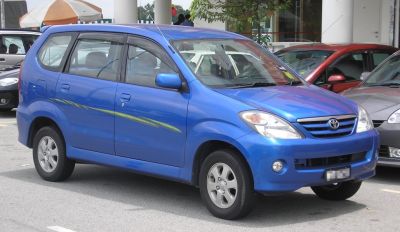 2004 Daihatsu Xenia I (F600) Dimensions, Size & Specs
2004 Daihatsu Xenia I (F600) Dimensions, Size & SpecsMeasurements of the 2004 Daihatsu Xenia I, engineered for optimal performance and comfort
| Dimensions | |
|---|---|
| Length: | 4070 mm160.2 in13.4 ft |
| Width: | 1630 mm64.2 in5.3 ft |
| Height: | 1675 mm65.9 in5.5 ft |
The Daihatsu Xenia, produced from 2003 to 2011, is a practical and compact minivan designed to meet the needs of families and individuals seeking a versatile vehicle. Positioned within the MPV (Multi-Purpose Vehicle) segment, the Xenia offers an efficient footprint that combines drivability with ample interior space. Measuring 4070 mm (160.2 inches) in length, 1630 mm (64.2 inches) in width, and 1675 mm (65.9 inches) in height, the Xenia fits comfortably within the compact minivan category, making it ideal for urban and suburban driving. Its moderate width facilitates maneuverability in tight city spaces, while the height provides sufficient headroom for passengers across its seating rows. The vehicle's balanced dimensions ensure it is spacious enough for families, yet easy to park and handle compared to larger minivans. Manufactured during the mid-2000s, the Xenia's size and shape reflect design priorities focused on efficiency and practicality rather than luxury or oversized presence. These dimensions make it competitive with similar minivans in its class, offering a reliable transportation option where space utility and functional design are key concerns.
Discover the standout features that make the 2004 Daihatsu Xenia I a leader in its class
Have a question? Please check our knowledgebase first.
The 2004 Daihatsu Xenia has a length of 4070 mm (160.2 inches), a width of 1630 mm (64.2 inches), and a height of 1675 mm (65.9 inches). These dimensions classify it as a compact minivan, balancing interior space with maneuverability, making it suitable for urban and suburban driving.
With a width of 1630 mm (64.2 inches), the Daihatsu Xenia is relatively narrow compared to many vehicles in its class. This compact width enhances its maneuverability in urban environments, making parking and navigating through congested city streets more convenient. The narrower profile is especially beneficial for tight parking spaces and narrow lanes.
The Daihatsu Xenia stands at 1675 mm (65.9 inches) tall. This height provides ample headroom inside, contributing to passenger comfort, especially for taller occupants. However, being a minivan with a relatively tall stature, this height can affect aerodynamic performance and may slightly influence stability at higher speeds or in strong crosswinds, common for vehicles designed with spacious cabins.
While specific ground clearance data for the 2004 Daihatsu Xenia is not explicitly provided here, typical minivans of this class usually feature moderate ground clearance to balance ride comfort with capability on uneven terrain. The Xenia is generally designed for urban and light off-road use, so it should handle minor bumps and rough roads fairly well, though not designed for heavy off-roading.
A standard residential garage typically measures around 2438 mm (96 inches) in width and 5486 mm (216 inches) in length. Given the Daihatsu Xenia's dimensions—4070 mm (160.2 inches) length and 1630 mm (64.2 inches) width—the vehicle fits comfortably within a standard garage. The height of 1675 mm (65.9 inches) also poses no issue for typical garage clearances.
The 2004 Daihatsu Xenia maintained much of the compact form factor of its predecessor but introduced slight dimensional refinements to enhance interior space and overall appeal. Length and width remained similar, around the low 4-meter range in length and approximately 1600 mm in width. Adjustments were made primarily to improve cabin comfort and ride quality without significantly altering the familiar compact minivan footprint.
Compared to other compact minivans from the early 2000s, such as the Suzuki APV or Honda Mobilio, the Daihatsu Xenia is similar in length and width but generally offers competitive height for interior space. Its length of 4070 mm (160.2 inches) is slightly shorter than some competitors, contributing to easier maneuverability, while still providing sufficient passenger and cargo room for a family vehicle.
The 2004 Daihatsu Xenia is typically designed as a 7-seater minivan, arranged in three rows of seating. The vehicle optimizes interior space within its compact dimensions, offering reasonable headroom and legroom for passengers across all three rows. This setup is ideal for family use, providing versatility for transporting people and cargo in urban and suburban settings.
While exact weight figures for the 2004 Daihatsu Xenia aren't specified here, compact minivans in this category usually weigh between 1100 kg to 1300 kg (2425 to 2866 lbs). This moderate weight supports fuel efficiency and ease of handling. The vehicle's relatively light mass compared to larger minivans helps improve mileage, making it a practical choice for families seeking economical transportation.
The Daihatsu Xenia, being a 7-seater minivan, offers versatile cargo space by allowing rear seats to be folded or removed. While exact cargo dimensions vary depending on seat configuration, with seats up the cargo area is modest but sufficient for everyday luggage and groceries. Folding down the rear seats substantially increases the available cargo space, allowing for larger or bulkier items, making it highly practical for family and utility needs.
Discover similar sized cars.

| Production: | 2003-2006 |
|---|---|
| Model Year: | 2003 |
| Length: | 4070 mm160.2 in |
| Width: | 1630 mm64.2 in |
| Height: | 1685 mm66.3 in |
